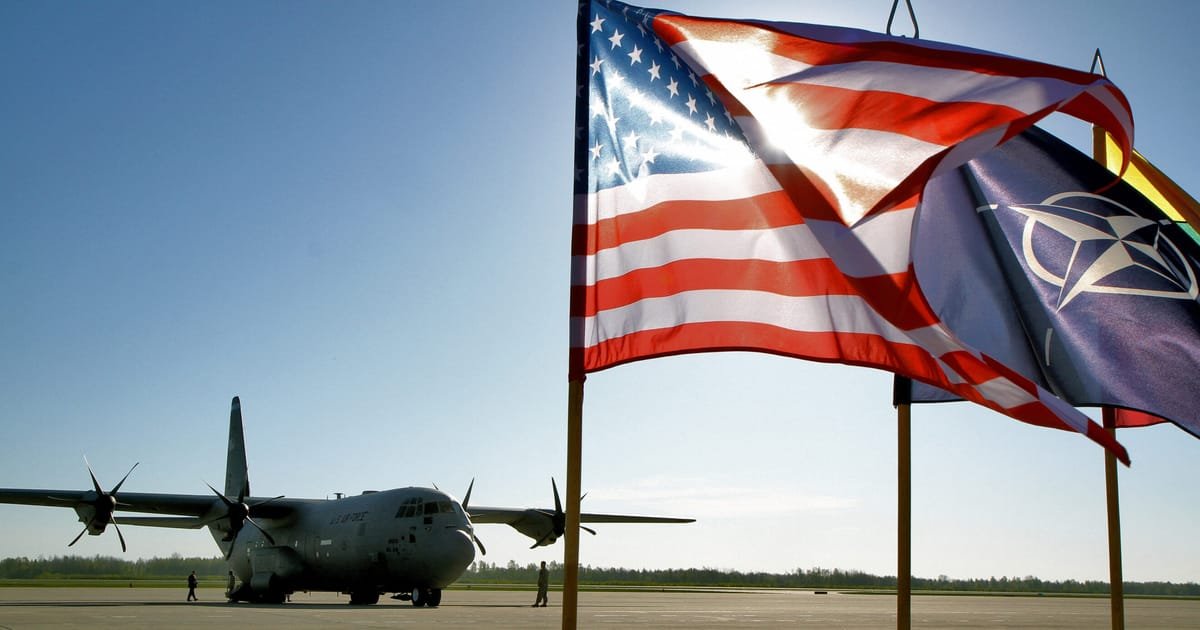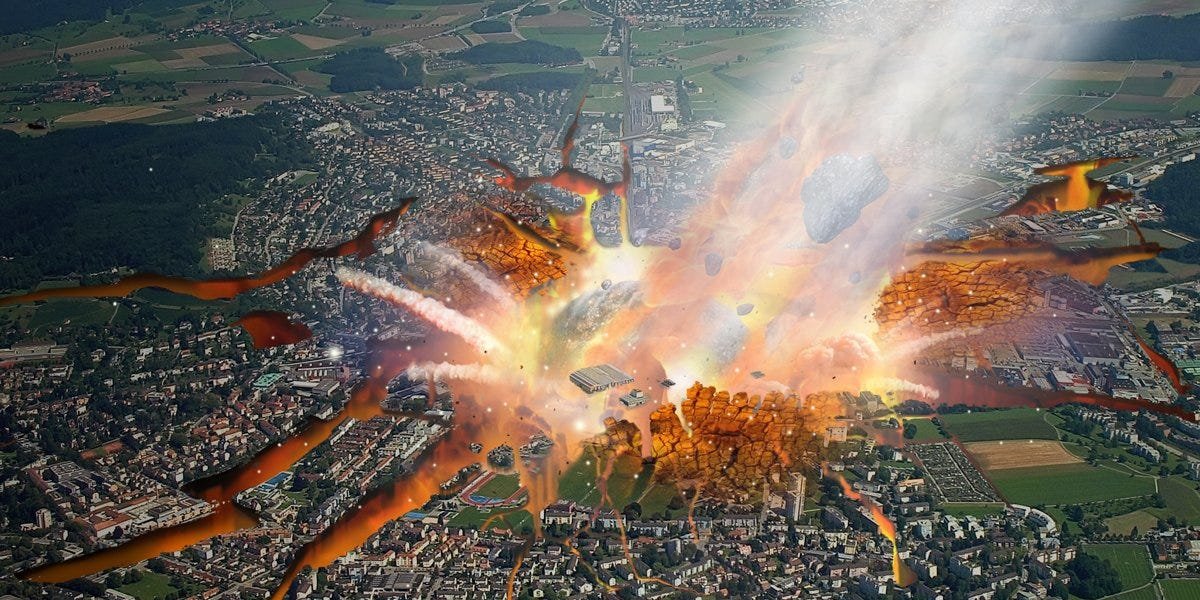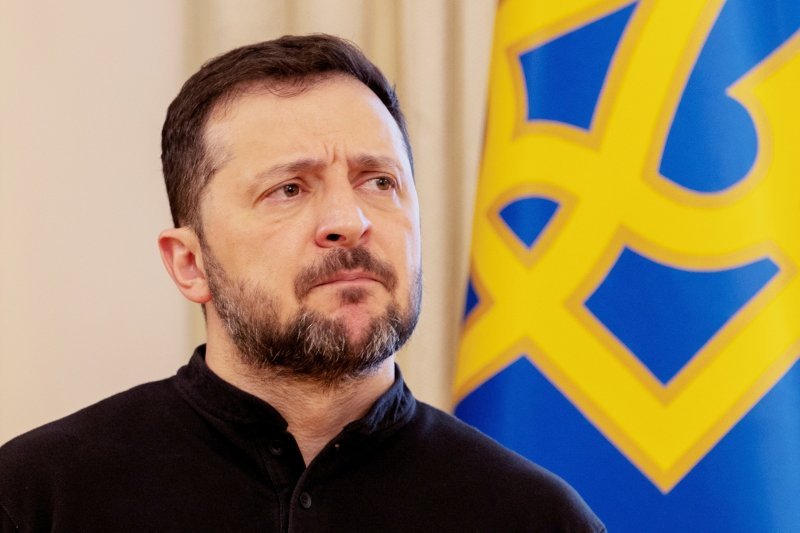Europe has built its war-fighting plans on speeding American reinforcements to the front lines. The prospect of that not happening is throwing military mobility plans into disarray.
AI generated Text-to-speech
It’s March 22, 2030. In the early spring mist, the roar of tank engines rips through the air. Overhead, missiles and fighter jets scream toward their targets, artillery thunders in the distance, and swarms of drones rise into the sky.
Lithuania’s Šiauliai Air Base erupts in flames. Warheads slam into Poland’s 22nd Air Base in Malbork. At the Rūdninkai military complex in Lithuania, German troops scramble for cover.
The Russians are on the move. Smashing east from the Russian exclave of Kaliningrad and west from Moscow’s satellite of Belarus, they hammer NATO defenses along the Suwałki Gap — the thin strip of land along the Polish and Lithuanian border.
While NATO forces in Lithuania and Poland struggle to hold back the Russians, allied countries rush to respond. Armies in Germany, France, Italy, the United Kingdom and the Nordic countries mobilize — but there is one stark absence.
Leaders and soldiers alike look westward, to the ocean, hoping for the warships that have always come to Europe’s rescue over the past century. But the sea offers only silence. The Americans aren’t coming.
Donald Trump’s second presidency has ended the United States’ commitment to European defense. The continent stands alone — which turns out to be a massive problem when it comes to reinforcing the embattled troops holding the line in Lithuania.
Ever since NATO was founded in 1949, one of the key roles of the alliance’s European members has been to resist an invasion while the U.S. gathered its immense power and sent troops, equipment and supplies across the Atlantic to win the longer war. Ports like Rotterdam and Antwerp were supposed to disembark the men and materiel and then allow them to use roads and rail to head toward the fighting.
But planners never envisioned a NATO without the United States, and for decades, Europe’s military logistics have been built on the assumption of American support. Much of the continent’s transport infrastructure — constructed or upgraded during the Cold War — still runs west to east, shaped by the expectation that U.S. reinforcements would arrive from across the Atlantic.
Some of the continent’s most strategic corridors are NATO-led efforts, including the most developed, which stretches from the Dutch coast to the Polish side of the Suwałki Gap. “These corridors are critical because they allow NATO and our allies to reach the eastern flank faster,” Lithuanian Deputy Defense Minister Tomas Godliauskas told POLITICO in a phone interview.
Both legacy and new military mobility projects rest on the premise that the Americans will come — a belief that remains largely unchallenged, even as the U.S. political commitment to Europe shows increasing signs of strain.
“Whether or not the United States stays involved in NATO or Europe is a legitimate question,” former U.S. Army Europe Commander Ben Hodges told POLITICO. “I worry about that. I hope like hell that we don’t significantly change our commitment to Europe. It would be a terrible mistake for the United States.”
But what happens if America abandons Europe? The uncomfortable reality is that without U.S. support, moving troops across Europe would be slower, costlier and hampered by a patchwork of logistical bottlenecks. In a real crisis, that might not just be inefficient — it could be fatal.
European leaders have long debated strategic autonomy, but they’ve done so within a system where Washington still controls the core tools of military mobility — the aircraft, ships, fuel lines, satellites, cyber defenses and interoperability standards that hold it all together.
“There are important capabilities, which we are depending on the U.S. for,” said Kimberley Kruijver, a researcher at Dutch consultancy TNO.
Europe lacks heavy transport aircraft, military cargo ships and the specialized vehicles required to move tanks and armored units. “We can move lighter vehicles, but not the heavier stuff,” Kruijver said.
Jannik Hartmann, a fellow at the German Council on Foreign Relations, confirmed that a U.S. pullback — from Germany’s Ramstein Air Base, for instance — would leave Europe without basic loading gear like ramps and flatbed wagons. Europe also has few forward stockpiles of military hardware, whereas the U.S. has pre-positioned supplies across Germany, Poland and the Netherlands, Kruijver said.
Air-to-air refueling — essential in contested airspace — is still largely a U.S. domain. Europe’s defense of its eastern flank relies on American-financed NATO fuel networks stretching across the continent. If Washington retreats, countries like France and Germany would scramble to fill the gap, Hartmann wrote in a LinkedIn post.
The dependence extends beyond logistics: Europe also relies on U.S. intelligence, cyber defenses and hybrid threat detection. “If the U.S. pulls back, real-time intelligence and satellite surveillance will be the first to suffer,” said Simon Van Hoeymissen, a researcher at the Brussels-based Royal Higher Institute for Defense.
U.S. cybersecurity capabilities play a crucial role in defending Europe’s military networks. Without them, the continent’s infrastructure would become an easy target for cyberattacks, sabotage and disinformation campaigns. Even with increased investment, Europe would struggle to replace these capabilities in the short term, Hartmann noted.
But even assuming Europe could procure its own assets, moving troops, tanks and fuel across the continent — and not necessarily along the old west-to-east pathway traditional to NATO — would be a challenge.
Hodges called European infrastructure “one of the greatest challenges” to military mobility.
“If you put a Patriot launcher on a rail car, is it going to fit through every tunnel? If they’re in a convoy, can they get under every bridge safely?” he asked. “Can the bridges in Eastern and Southern Europe hold the weight of a 70- to 75-ton tank?”
The answer, usually, is no.
Europe’s rail network is not designed for large-scale rapid military movements, wrote Sergei Boeke, political adviser at NATO’s European Joint Support and Enabling Command in a paper on European military mobility.
Weak bridges, sharp curves, narrow tunnels and poorly placed signs make it difficult to move heavy armor quickly by rail — and the roads aren’t much better. Yellow bridge classification signs, which indicate how much weight a bridge can carry, have become rare in many countries. And unlike Cold War-era designs, most of today’s infrastructure was never intended for military use.
While hardware is an obvious issue, another less visible — but arguably more dangerous — weakness lies in coordination.
In peacetime, bureaucracy hinders mobility: Permits, national regulations and siloed procedures slow everything down. In wartime, such red tape would likely be brushed aside, but removing the paperwork doesn’t fix the deeper problem of who actually coordinates the movement.
The only body that arguably holds a full picture of military mobility in Europe isn’t housed in the glass towers of NATO’s HQ in Brussels — it’s based on a military compound in Ulm, Germany. That’s where JSEC operates.
Tasked with overseeing routes, choke points and movement planning under NATO’s Reinforcement and Sustainment Network, JSEC maps critical nodes, plans for emergencies, and monitors the strategic corridors linking key allies — from the Netherlands to Poland, and from Greece to Romania.
JSEC falls under the authority of NATO’s supreme allied commander Europe — a position always held by an American general, Hartmann noted — meaning that the leadership of Europe’s most comprehensive effort at coordinated, continent-wide mobility still runs through Washington.
The Trump administration is reportedly contemplating handing that role to a European for the first time since the alliance was founded, underlining America’s dwindling interest in European defense.
Moreover, according to Van Hoeymissen, coordination and information-sharing between JSEC and the European Union remains patchy, due largely to diverging memberships and political tensions among member countries.
These coordination challenges can be mitigated by military exercises among EU member countries, but there are growing concerns the U.S. may scale down its participation in European exercises beyond those already scheduled for this year, Hartmann warned. “If confirmed, it would be a significant blow,” he said.
Efforts are being made to improve the situation. JSEC Commander Lt. Gen. Kai Rohrschneider told POLITICO that his command is engaging with countries to assess and refine “minimum operational requirements” for the transport network.
This process involves identifying critical infrastructure and logistical nodes, understanding who operates and supports them, and encouraging nations to adopt a more flexible military mobility system.
Regarding Europe’s efforts to gain strategic independence, Rohrschneider emphasized the continent’s key role in strengthening military mobility. “From an enablement perspective, it is fundamentally a European effort that needs to be reinforced,” he said, adding the impression is that “Europe is indeed working very hard to achieve it.”
JSEC is collaborating closely with the European Commission and its transport division, DG MOVE, maintaining what Rohrschneider described as a “permanent exchange” with EU institutions.
The EU is working to get its act together. A new military mobility communication is expected in the second half of 2025, targeting infrastructure bottlenecks and regulatory red tape, with the topic of military mobility already featured in the ReArm Europe package and the EU’s white paper on defense.
Speaking before the European Parliament on April 2, Transport Commissioner Apostolos Tzitzikostas announced that the Commission is drafting a new plan to streamline rules on hazardous goods, lift outdated weight restrictions, and remove bureaucratic choke points.
“Within the corridors, we have a list of around 500 military mobility ‘hot spot’ projects,” he said, citing input from both national defense ministries and NATO. “Short-term, quick-win investments will reinforce road and railway bridges, widen tunnels, expand port infrastructure and lay railway sidings to increase capacity.”
His head of cabinet, Anna Panagopoulou, on April 9 also flagged an upcoming European ports strategy to ensure the continent’s harbors can absorb the logistical demands of war.
Member countries are also taking the initiative and looking to Brussels for extra cash.
“Lithuania hopes to secure EU funding for the [Suwałki Gap] project,” Godliauskas said.
However, all of those plans still rely on the old model of building up west-east infrastructure based on an alliance with the U.S. — an assumption that is increasingly in doubt.
If the Americans don’t ultimately show up, none of it — neither the corridors, the ports, nor the meticulously crafted logistics — may stand a chance, because the ships and planes they count on could remain parked thousands of miles away.
By investing heavily in a war strategy built on U.S. support that may never materialize, Europe risks preparing for the wrong conflict — one where ports and beaches stay empty, while the European factories building tanks and the bases training troops are severed from the front. Yet few experts — or policymakers — seem willing to confront that possibility.
If the Americans step back, “the [Russian] threat will only get worse,” Hodges said.
“If the Russians think the United States won’t stay committed, the risk of them making a terrible decision increases,” he explained, meaning that “the problem [of military mobility] has got to be solved — regardless of whether the U.S. is there or not.”
The project aims to make it easier to move troops and equipment between Poland and the Baltic countries.
The US cavalry isn’t coming: How Europe moves its armies without American assistance – politico.eu



